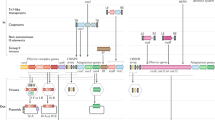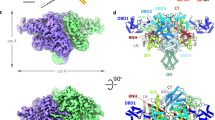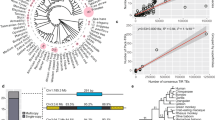Abstract
Transposons are DNA sequences that encode functions that promote their movement to new locations in the genome. If unregulated, such movement could potentially insert additional DNA into genes, thereby disrupting gene expression and compromising an organism's viability. Transposable elements are classified by their transposition mechanisms and by the transposases that mediate their movement. The mechanism of movement of the eukaryotic hAT superfamily elements was previously unknown, but the divergent sequence of hAT transposases from other elements suggested that these elements might use a distinct mechanism. Here we have analysed transposition of the insect hAT element Hermes in vitro. Like other transposons, Hermes excises from DNA via double-strand breaks between the donor-site DNA and the transposon ends, and the newly exposed transposon ends join to the target DNA. Interestingly, the ends of the donor double-strand breaks form hairpin intermediates, as observed during V(D)J recombination, the process which underlies the combinatorial formation of antigen receptor genes. Significant similarities exist in the catalytic amino acids of Hermes transposase, the V(D)J recombinase RAG, and retroviral integrase superfamily transposases, thereby linking the movement of transposable elements and V(D)J recombination.
This is a preview of subscription content, access via your institution
Access options
Subscribe to this journal
Receive 51 print issues and online access
$199.00 per year
only $3.90 per issue
Buy this article
- Purchase on Springer Link
- Instant access to full article PDF
Prices may be subject to local taxes which are calculated during checkout





Similar content being viewed by others
References
Lander, E. S. et al. Initial sequencing and analysis of the human genome. Nature 409, 860–921 (2001)
Venter, J. C. et al. The sequence of the human genome. Science 291, 1304–1351 (2001)
Haren, L., Ton-Hoang, B. & Chandler, M. Integrating DNA: transposases and retroviral integrases. Annu. Rev. Microbiol. 53, 245–281 (1999)
Craig, N., Craigie, R., Gellert, M. & Lambowitz, A. Mobile DNA II (ASM, Washington DC, 2002)
Rice, P. A. & Baker, T. A. Comparative architecture of transposase and integrase complexes. Nature Struct. Biol. 8, 302–307 (2001)
Rubin, E., Lithwick, G. & Levy, A. A. Structure and evolution of the hAT transposon superfamily. Genetics 158, 949–957 (2001)
Kunze, R. W. & Weil, C. F. in Mobile DNA II (eds Craig, N. L., Craigie, R., Gellert, M. & Lambowitz, A.) 565–610 (ASM, Washington DC, 2002)
Robertson, H. M. in Mobile DNA II (eds Craig, N. L., Craigie, R., Gellert, M. & Lambowitz, A.) 1093–1110 (ASM, Washington DC, 2002)
Calvi, B. R., Hong, T. J., Findley, S. D. & Gelbart, W. M. Evidence for a common evolutionary origin of inverted repeat transposon in Drosophila and plants: hobo, Activator, and Tam3. Cell 66, 465–471 (1991)
Warren, W. D., Atkinson, P. W. & O'Brochta, D. A. The Hermes transposable element from the house fly, Musca domestica, is a short inverted repeat-type element of the hobo, Ac, and Tam3 (hAT) element family. Genet. Res. 64, 87–97 (1994)
O'Brochta, D. A., Warren, W. D., Saville, K. J. & Atkinson, P. W. Hermes, a functional non-Drosophilid insect gene vector from Musca domestica. Genetics 142, 907–914 (1996)
Gellert, M. V(D)J recombination: RAG proteins, repair factors, and regulation. Annu. Rev. Biochem. 71, 101–132 (2002)
Roth, D. B., Menetski, J. P., Nakajima, P. B., Bosma, M. J. & Gellert, M. V(D)J recombination: broken DNA molecules with covalently sealed (hairpin) coding ends in SCID mouse thymoctes. Cell 70, 983–991 (1992)
Okuda, M., Ikeda, K., Namiki, F., Nishi, K. & Tsuge, T. Tfo1: an Ac-like transposon from the plant pathogenic fungus Fusarium oxysporum. Mol. Gen. Genet. 258, 599–607 (1998)
Sarkar, A. et al. The Hermes element from Musca domestica can transpose in four families of cyclorrhaphan flies. Genetics 99, 15–29 (1997)
Kennedy, A., Guhathakurta, A., Kleckner, N. & Haniford, D. B. Tn10 transposition via a DNA hairpin intermediate. Cell 95, 125–134 (1998)
Bhasin, A., Goryshin, I. Y. & Reznikoff, W. S. Hairpin formation in Tn5 transposition. J. Biol. Chem. 274, 37021–37029 (1999)
Hiom, K., Melek, M. & Gellert, M. DNA transposition by the RAG1 and RAG2 proteins: a possible source of oncogenic translocations. Cell 94, 463–470 (1998)
Agrawal, A., Eastman, O. M. & Schatz, D. G. Transposition mediated by RAG1 and RAG2 and its implications for the evolution of the immune system. Nature 394, 744–751 (1998)
van Gent, D. C., Mizuuchi, K. & Gellert, M. Similarities between initiation of V(D)J recombination and retroviral integration. Science 271, 1592–1594 (1996)
Kennedy, A. K., Haniford, D. B. & Mizuuchi, K. Single active site catalysis of the successive phosphoryl transfer steps by DNA transposases: insights from phosphorothioate stereoselectivity. Cell 101, 295–305 (2000)
Mizuuchi, K. & Adzuma, K. Inversion of the phosphate chirality at the target site of the Mu DNA strand transfer: evidence for a one-step transesterification mechanism. Cell 66, 129–140 (1991)
Michel, K., O'Brochta, D. A. & Atkinson, P. W. The C-terminus of the Hermes transposase contains a protein multimerization domain. Insect Biochem. Mol. Biol. 33, 959–970 (2003)
Namgoong, S. & Harshey, R. The same two monomers within a MuA tetramer provide the DDE domains for the strand cleavage and strand transfer steps of transposition. EMBO J. 17, 3775–3785 (1998)
Williams, T. L., Jackson, E. L., Carritte, A. & Baker, T. A. Organization and dynamics of the Mu transpososome: recombination by communication between two active sites. Genes Dev. 13, 2725–2737 (1999)
Coen, E. S., Carpenter, R. & Martin, C. Transposable elements generate novel spatial patterns of gene expression in Antirrhinum majus. Cell 47, 285–296 (1986)
Weil, C. F. & Kunze, R. Transposition of maize Ac/Ds transposable elements in the yeast Saccharomyces cerevisiae. Nature Genet. 26, 187–190 (2000)
Ma, Y., Pannicke, U., Schwarz, K. & Lieber, M. R. Hairpin opening and overhang processing by an Artemis/DNA-dependent protein kinase complex in nonhomologous end joining and V(D)J recombination. Cell 108, 781–794 (2002)
Yu, J., Marshall, K., Yamaguchi, M., Haber, J. E. & Weil, C. F. Microhomology-dependent end joining and repair of transposon-induced DNA hairpins by host factors in Saccharomyces cerevisiae. Mol. Cell. Biol. 24, 1351–1364 (2004)
Qiu, J. X., Kale, S. B., Yarnell, S. H. & Roth, D. B. Separation-of-function mutants reveal critical roles for RAG2 in both the cleavage and joining steps of V(D)J recombination. Mol. Cell 7, 77–87 (2001)
Lee, G., Neiditch, M., Salus, S. & Roth, D. RAG proteins shepherd double-strand breaks to a specific pathway, suppressing error-prone repair, but RAG nicking initiates homologous recombination. Cell 117, 171–184 (2004)
Thompson, J. D., Higgins, D. G. & Gibson, T. J. CLUSTAL W: improving the sensitivity of progressive multiple sequence alignment through sequence weighting, positions-specific gap penalties and weight matrix choice. Nucleic Acids Res. 22, 4673–4680 (1994)
Sarnovsky, R., May, E. W. & Craig, N. L. The Tn7 transposase is a heteromeric complex in which DNA breakage and joining activities are distributed between different gene products. EMBO J. 15, 6348–6361 (1996)
Piccirilli, J. A., Vyle, J. S., Caruthers, M. H. & Cech, T. R. Metal ion catalysis in the Tetrahymena ribozyme reaction. Nature 361, 85–88 (1993)
Allingham, J., Pribil, P. & Haniford, D. All three residues of the Tn10 transposase DDE catalytic triad function in divalent metal ion binding. J. Mol. Biol. 289, 1195–1206 (1999)
Brautigam, C. & Steitz, T. Structural and functional insights provided by crystal structures of DNA polymerases and their substrate complexes. Curr. Opin. Struct. Biol. 8, 54–63 (1998)
Dyda, F. et al. Crystal structure of the catalytic domain of HIV-1 integrase: similarity to other polynucleotidyl transferases. Science 266, 1981–1986 (1994)
McGuffin, L. J., Bryson, K. & Jones, D. T. The PSIPRED protein structure prediction server. Bioinformatics 16, 404–405 (2000)
Kim, D. R., Dai, Y., Mundy, C. L., Yang, W. & Oettinger, M. A. Mutations of acidic residues in RAG1 define the active site of the V(D)J recombinase. Genes Dev. 13, 3070–3080 (1999)
Fugmann, S. D., Villey, I. J., Ptaszek, L. M. & Schatz, D. G. Identification of two catalytic residues in RAG1 that define a single active site within the RAG1/RAG2 protein complex. Mol. Cell 5, 97–107 (2000)
Landree, M. A., Wibbenmeyer, J. A. & Roth, D. B. Mutational analysis of RAG1 and RAG2 identifies three catalytic amino acids in RAG1 critical for both cleavage steps of V(D)J recombination. Genes Dev. 13, 3059–3069 (1999)
Walbot, V. in Mobile DNA II (eds Craig, N. L., Craigie, R., Gellert, M. & Lambowitz, A.) 533–563 (ASM, Washington DC, 2002)
Sarkar, A. et al. Molecular evolutionary analysis of the widespread piggyBac transposon family and related “domesticated” sequences. Mol. Genet. Genom. 270, 173–180 (2003)
Roberts, R. & Cheng, X. Base flipping. Annu. Rev. Biochem. 67, 181–198 (1998)
Davies, D. R., Braam, L. M., Reznikoff, W. S. & Rayment, I. The three-dimensional structure of a Tn5 transposase-related protein determined to 2.9 Å resolution. J. Biol. Chem. 274, 11904–11913 (1999)
Ason, B. & Reznikoff, W. S. Mutational analysis of the base flipping event found in Tn5 transposition. J. Biol. Chem. 277, 11284–11291 (2002)
Huye, L. E., Purugganan, M. M., Jiang, M. M. & Roth, D. B. Mutational analysis of all conserved basic amino acids in RAG-1 reveals catalytic, step arrest, and joining-deficient mutants in the V(D)J recombinase. Mol. Cell. Biol. 22, 3460–3473 (2002)
Bankhead, T. & Chaconas, G. Mixing active-site components: a recipe for the unique enzymatic activity of a telomere resolvase. Proc. Natl Acad. Sci. USA 101, 13768–13773 (2004)
De, P. & Rodgers, K. Putting the pieces together: identification and characterization of structural domains in the V(D)J recombination protein RAG1. Immunol. Rev. 200, 70–82 (2004)
Lewis, S. M. & Wu, G. E. The origins of V(D)J recombination. Cell 88, 159–162 (1997)
Acknowledgements
We are grateful to G. Chaconas for sharing his thoughts about hairpin binding pockets before publication. N.L.C. is an Investigator of the Howard Hughes Medical Institute.
Author information
Authors and Affiliations
Corresponding author
Ethics declarations
Competing interests
The authors declare that they have no competing financial interests.
Supplementary information
Rights and permissions
About this article
Cite this article
Zhou, L., Mitra, R., Atkinson, P. et al. Transposition of hAT elements links transposable elements and V(D)J recombination. Nature 432, 995–1001 (2004). https://doi.org/10.1038/nature03157
Received:
Accepted:
Issue Date:
DOI: https://doi.org/10.1038/nature03157
This article is cited by
-
Zinc-finger BED domains drive the formation of the active Hermes transpososome by asymmetric DNA binding
Nature Communications (2023)
-
Structural basis of seamless excision and specific targeting by piggyBac transposase
Nature Communications (2020)
-
Structures of a RAG-like transposase during cut-and-paste transposition
Nature (2019)
-
Diversity and evolution of the repetitive genomic content in Cannabis sativa
BMC Genomics (2018)
-
Functional characterization of the active Mutator-like transposable element, Muta1 from the mosquito Aedes aegypti
Mobile DNA (2017)
Comments
By submitting a comment you agree to abide by our Terms and Community Guidelines. If you find something abusive or that does not comply with our terms or guidelines please flag it as inappropriate.



